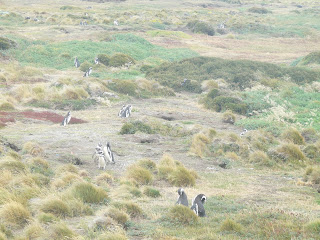The penguins were everywhere. Smallish, knee-high birds with long-thin flippers that they sometimes used to hug each other or walk arm-in-arm,
they waddled with an intensity that was probably more just a matter of having to move their feet fast enough so they didn’t fall over forwards.
They leaned their bodies forward when they walked, and when they came up out the burrows they’d dug in the seaside soil.
Penguin paths worn through the long wiry glass took them from their burrow to the stony beach.
Like all penguins, awkward on land, once in the water they bobbed and swam with such grace, it was like watching a dance.
The air was full of feathers, swirling like huge flakes of snow. The babies, big and fat at three months old, had yet to go in the water, but right now they are preparing by molting their baby fluff feathers and developing their adult waterproof coat.
They spent a lot of time preening, actually all the birds did. They spent a lot time, too, posing for the many cameras clicking away. They’d walk, and then suddenly freeze, although it wasn’t out of fear, because they showed no notice of all the people walking by. They have few predators, sea lions in the water, and the occasional fox on land.
Patagonia is the southern-most part of South America. Both Chile and Argentina have area here, although the people tend to think of themselves as Patagonian first and their nationality second. Grasslands and lots of wind. Sound familiar, those of you in the prairies? It very hilly, though, and so is different.
We then went to a sheep farm. Sheep are known as range maggots in the United Kingdom, but I didn’t hear any such derogatory term here. Chilean Patagonia is largely agricultural, and farms tend to be big. A small one is 5000 acres, and the largest one in the area was 70,000, although that was two separate pieces of land.
Most farms focus on sheep, and some cattle. We were treated to a demonstration of sheep-herding, by a man on a horse and two very happy dogs.
We also watched a sheep get sheared the old fashioned way, with hand-shears. A good shearer can shear 200 to 250 sheep a day.
The farm was lovely and interesting, and the experience was made slightly surreal by the sudden sight of a herd of baby llamas. Unpenned, they roamed the large area freely. They'd appear out of nowhere, running down a road, or across a field, or from behind our parked bus. They were only four months old and so, while they are approaching their adult height, they are thin and leggy, mostly because they haven’t yet put on their adult hair. It was difficult to take photos of them, because their appearance was always unexpected, and they can run fast.
Friday, January 29, 2010
Subscribe to:
Post Comments (Atom)














Really great pictures and narration. I have a Shetland sheep dog (sheltie) now and she "herds" me. She constantly touches her nose to the back of my leg as I walk. Really funny. She is still a puppy (born in May) and we are really enjoying her. It took Jerry (our lab) a while to get used to her but they play together now.
ReplyDelete